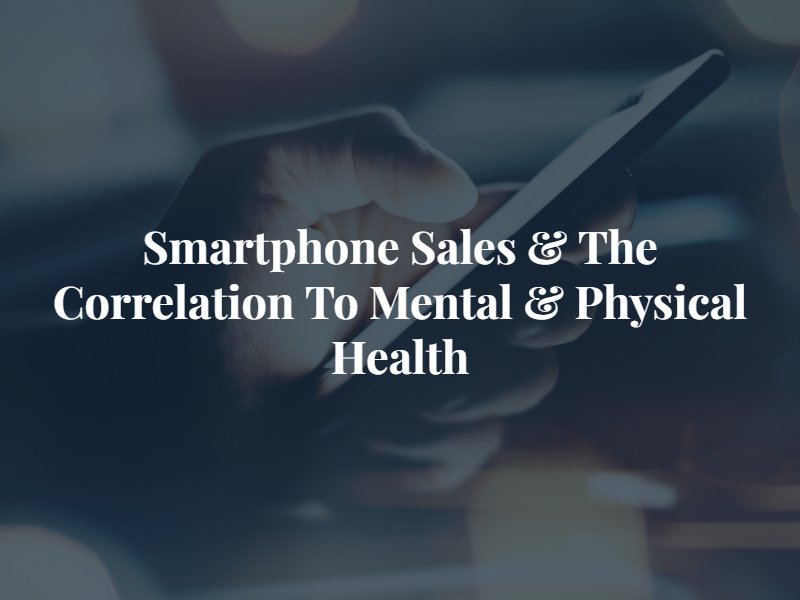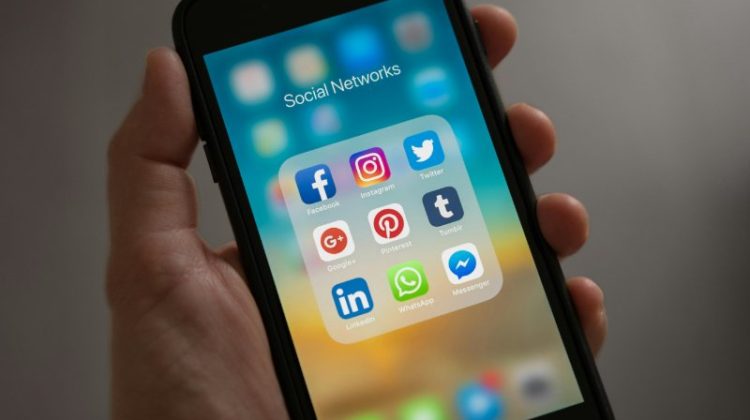Depression and anxiety rates among adolescents, teenagers, young adults and Americans in general have steadily increased since 2008.
The sales of smartphones in the United States have also ballooned during this same time period.
Between 2008 and 2020, sales of smartphones have increased from $11.3 Billion in 2008, to $79.1 billion dollars in annual sales. In a twelve year period, the industry increased their annual sales by 694%
Between the time periods of 1988-1994 through the time periods of 2005-2008, the rate of antidepressant use in the United States among all age groups increased nearly 400%.
Antidepressant usage continued to increase. In 2008, 12.7% % of people in the United States reported taking medication to help curb depression.
In the years between 2015-2018 13.2% % of people in the United States were taking antidepressants.
While sales of smartphones have spiked in the last decade, so too have reported cases of mental health issues. A recent study identified that the average person will spend nine years of their life using a smartphone. This amount of time spent looking at screens increases with younger generations as Millenials spend more time compared to Gen X and Baby Boomers.
Gen Z’s and future generations of the 21st century can reasonably expect to see an increase in this amount of time spent on mobile devices.
The massive amounts of time spent utilizing smart phones, have shown to be a contributing factor to mental health ailments. As more and more utilities shift from more traditional platforms to ones involving mobile devices, the future is likely to include even more time spent on a mobile phone based on recent trends.
The rise of smartphones has led to a shift in the day to day interactions, how people communicate, how individuals “socialize” and how we spend our time. In 2019, the average person spent three and half hours per day on their mobile device. With the increase of time spent engaging on social media and mobile devices, so too have reports of mental health issues in Americans.
A Brief History of Social Media
Social media is older than many people realize. While social media has become a mainstay for individuals across the globe to engage and socialize, the roots of social media as we know it today began at the turn of the millennium.
While social media and smartphones are two distinct entities that are unique from one another, individuals have spent substantially more amounts of time browsing social media sites via a smartphone compared to individuals that browse on a laptop or desktop device.
In 2008, the percentage of Americans in the United States that utilized social media was 10%. In 2021, that number has ballooned to 82%. This growth coincides with the growth of smartphones within the United States from 2008. The more smartphones that entered the hands of Americans, so too did the time an average individual utilized social media.
2002 – Friendster was one of the first social media platforms that allowed individuals to create profile pages and connect with other individuals.
2003 – Linkedin was launched with a focus for a social media site for professionals. Since its inception in 2003, the company now employs more than 18,000 people.
Myspace also debuted in 2003 and became a social media giant in the Mid 2000’s. Eventually the company was usurped by a larger social media company in daily users.
2004 – Mark Zuckerberg launches Facebook. Initially limited to Ivy League schools and college students, the social media giant has become a juggernaut in the digital age. In quarter 1 of 2021, the company had more than 2.7 billion monthly active users and has been publicly traded on the NASDAQ since 2012.
2006 – Twitter is launched by creators Jack Dorsey, Noah Glass, Biz Stone & Evan WIlliams. As of late 2020, the company has more than 330 million monthly users.
2011 – Snapchat is launched by CEO Evan Spiegal and several other investors. The social media platform becomes increasingly popular and is listed publicly on the New York Stock Exchange in 2017.
2011 was also the year that social media giant Facebook allowed sponsored content on their site. This sponsored content would make national headlines in the 2016 US presidential election.
Social Media & Mental Health
Advertisements disseminated in marketing campaigns have negatively impacted self images for decades.
Social media has helped exacerbate this problem.
Research conducted has determined that children, teenagers and young adults that spend large amounts of time on social media platforms were shown to have a higher rate of depression compared to their peers that do not spend the same amounts of time on social media platforms.
The correlation between the rise of social media engagement and the amount of cell phones since 2018 also correlates to a rise in depression, anxiety and suicidal tendencies. Although social media and smartphones have enabled individuals to connect with virtually any other person on the planet that has an internet connection, the interactions experienced in a digital landscape opposed to a real-world landscape are entirely unique and distinct from one another.
While positive digital interactions that result in “likes” may create similar endorphins to real-world interactions, these digital interactions do not have the same long term impact on an individual that in person socialization has on an individual. Rather, the amount of time that an individual spends on social media could be spent learning a new skill or engaging in physical activity.
Since smartphones rose to their current sales levels, teenagers and young adults have shifted their behaviors from physical, in person engagement to one more focused on digital engagement. While it may be viewed as a good sign that younger generations are engaging in less risky physical behavior, the ripple effects caused by smartphones and social media usage can result in poorer self esteem, social anxiety and the fear of missing out.
Instagram & Suicidal Tendencies
In September 2021, Facebook, the parent company of Instagram, reported that 13% of teenagers in Great Britain and 6% of American users could trace these suicidal thoughts to Instagram. The report also mentions that 32% of teenage girls that had already said they felt bad about their bodies, had these feelings exacerbated by Instagram. For teenage boys, this number was lower than their female counterparts as teenage boys checked in at 14% of boys feeling worse about themselves after visiting Instagram.
Facebook mentioned that while the majority of teenagers did not have suicidal thoughts, the fact that more than 1 in 20 teenagers could trace their suicidal thoughts back to social media giant Instagram is deeply concerning.
Even with the concerning report from Facebook regarding suicidal tendencies in adolescent aged children, Instagram planned to roll out a social media platform catered to kids. However, this application was eventually postponed as a criticism from parents quickly mounted.
Smartphones & Mental Health
The stigma of mental health has slowly begun to dissipate. One of the silver linings of smartphones is that the stigma of mental health issues has gradually reduced since the rise of social media. As more and more social media outlets permeated through the digital landscape, so too did users stories regarding depression, anxiety, bipolar disorders and other mental health ailments.
However, some of these mental health stories can be tangiently related to the devices many of the users are posting from – cell phones.
While early smartphones existed as early as the 1990’s, smartphones, like BlackBerrys, emerged as a popular mobile device in the early to mid 2000’s. In 2006, the BlackBerry was colloquially nicknamed the “CrackBerry” as a result of the highly engaging and addictive nature of the phone. While BlackBerry was an industry innovator in the first decade of the new millennium, the smartphone landscape would change drastically and enter a new phase when Apple announced the iPhone in 2007.
The first generation of the iPhone was announced in the first quarter of 2007. Since this revolutionary product announcement, and the subsequent release to market, Apple has sold more than 2.2 billion iPhone devices worldwide. In 2008, Apple released the successor to the iPhone. The iPhone 3G included data that enabled a user to access faster speeds compared to the 2G networks and individuals from coast to coast in the United States were able to access the internet without being hardwired or connected to a Wi-Fi network. This accessibility to the internet dramatically increased the amount of time individuals were able to access the internet and correlates with the uptick in depression, anxiety and amount of time spent in front of a digital screen.
Have Smartphones Increased Screen Time?
In 2007 the average amount of time that children spent looking at a screen was drastically lower compared to 2017. Children’s internet consumption by age has increased substantially since the Iphone was announced in 2007.
In 2007 the average estimated weekly amount of hours a child between the ages of 12 to 15 was 14 hours per week. In 2017, a decade after the Iphone launched, 12 to 15 year olds were spending more than 20 hours on average on the internet. This increase equates to a 142% expansion in time spent over a ten year period. The twenty hours a week does not include watching television.
Children’s internet consumption correspondingly increased across age groups from 5 to 7 and 8 to 11 over this same ten year time period.
While internet consumption is a nearly imperative component for individuals in developed countries. The amount of time individuals spend utilizing mobile devices, means that there is less available time to learn new skills or socialize with friends and loved ones. The tradeoffs that one action has leads to ripple effects that can impact the quality of life, well-being and happiness. The amount of time spent utilizing a device connected to the internet could instead be spent engaging in in-person interactions.
Uncoincidentally, the amount of depressed individuals has increased during this same time period. A 2020 study published by the CDC examines the growing trend of individuals across age groups and depression rates.
How Much Has Depression Increased In The Last Decade?
It is difficult to pinpoint exactly how much depression has increased since 2007. Due to the number of individuals that do not seek out mental health services for their needs, depression statistics are very likely under reported. However, data is available for the amount of antidepressants that are used in the United States.
Between 2015 – 2018, 13.2% of American adults had used antidepressants in the last month. The amount of antidepressant usage increases with age for adults. Antidepressant usage was higher among females compared to males over this three year time period.
When we compare the time period from 2015-2018, with data accrued between 2009-2010, the amount of antidepressant usage increased from 10.6% to 13.8%. Women were more likely to implement and use antidepressants than men, but it is important to consider the stigma surrounding reaching out for mental health services that led many men to forgo mental health treatments, thus leading to an underreporting and potential skewed data of antidepressants in men.
The Rise of Ads in The Age of Misinformation
In 2021, the average individual is exposed to more than 5,000 ads a day. Some experts believe that the amount of ads an individual is exposed to can eclipse 10,000 ads a day. The average amount of advertisements Americans are exposed to on a daily basis has increased by a factor of 10 since the 1970s when individuals were exposed to roughly 500 ads per day.
While the amount of advertisements an individual is exposed to can vary substantially from state to state, industry to industry and person to person.
Americans today generally see between four and ten thousand ads daily.
A person that works in digital marketing for example is exposed to far more ads on a daily basis compared to tradesman or laborer in the construction industry. This ad volume contributes to ad fatigue, mental health problems and body image issues amongst Americans, especially younger generations of Americans.
Social media has been a catalyst for the inundation of ads. Facebook generates more than 98% of its revenue from ads, and other social media power companies such as Twitter, receive more than 85% of their annual revenue from ads. While these ads are a lucrative revenue stream for social media platforms, there are ripple effects that are felt throughout the market from the constant amount of ads Americans are exposed to. These advertisements and depictions of models in advertisement can result in lower confidence, poorer self esteem and ultimately higher depression rates for an individual consumer.
The American Psychological Association (APA) published a study that outlined that the sexualization of girls and young women in advertisements increased eating disorders, depression and low self esteem in females.
Smartphones & Distracted Driving
Smartphones have led to an increase in distracted driving incidents. In 2019, distracted driving claimed more than 3,142 lives.
While all of these distracted driving are not entirely attributed to distracted driving resulting from smartphones, the rise of smartphones also correlates to an increase in distracted driving accidents. Distracted driving accidents increased from 900,000 accidents involving distracted drivers in 2010 to 986,000 in 2019. This represented a growth in distracted driving accidents of 9.5% when we compare 2010 to 2019.
The National Safety Council reviewed police reports from all fifty states and the District of Columbia. The report identified that distracted driving accidents were not fully captured in the accident reports. From 2016 to 2018, more than 40,000 roadway deaths occured in the United States.
While the majority of Americans understand the extreme dangers of driving under the influence of drugs and/or alcohol, individuals from coast to coast continue to engage in a different type of influence. Driving under the influence-rs.
Smartphone & Distracted Walking
Driving is not the only means of transportation that is impacted by the distractions smartphones cause. Injuries from texting and walking are more common from texting and driving. A study published by the American Academy of Orthopedic Surgeons (AAOS) stated that more than 60% of pedestrians are distracted by other activities while walking.
Another recent study examined the correlation between pedestrian deaths and the usage of headphones by victims involved in pedestrian accidents. 67% of all individuals involved in the 116 deaths that were examined, identified many of these individuals were utilizing headphones before the fatal accident occurred. In these cases, 74% involved victims utilizing headphones when the fatal accident occurred.
40% of respondents to a distracted walking study stated that they have personally witnessed a distracted walking incident. 26% of individuals in this study self acknowledged that they have personally been involved in a distracted walking accident.
Teens and young adults between the ages of 16 and 25 were most likely to suffer an injury while texting and walking. Distracted pedestrians across all age groups may have been a contributing factor to the 4,200 deaths involving pedestrians and more than 70,000 injuries that involved traffic crashes in 2010. The delayed reaction time resulting from distracted communication and walking meant that individuals that were engaged with their phones took 18% longer to fully cross an intersection compared to their non-distracted counterparts.
How Can I Stay Safe While Driving or Walking?
As more and more studies are conducted about the dangers of distracted driving, walking and other activities, it is important for individuals to acknowledge and implement strategies to combat distracted behaviors during daily transits and commutes.
Take the pledge about phone safety and never use a cell phone while operating a motor vehicle or while walking. Remember to look up while walking as individuals that are engaged with their personal phones are more prevalent to be less engaged with their physical surroundings.
If it is mandatory to reply to a notification or message immediately, park your vehicle in a safe spot, and people on foot should move to a safe area without foot traffic or other pedestrians and respond to a message. Never text or use your phone while operating a moving vehicle. Not only is this illegal in many states, newer vehicles’ infotainment systems can also be reviewed by law enforcement after a car accident occurs.
Although distracted driving can lead to more severe and catastrophic injuries compared to distracted walking, both activities result in thousands of annual preventable injuries in the United States alone. By minimizing the amount of distractions a pedestrian or motor operator can engage in safer behavior as they are not distracted.
It may seem common to text and walk, or engage in a different activity, while utilizing a smartphone but there are far safer options available.
Conclusion
While there is a correlation between mobile devices and depression it is important to consider that mobile devices are not entirely responsible for this increase. Rather than are a common factor that are involved in depression and distracted driving and walking behaviors.
As internet usage and screen time increases from one year to another and increases from older generations to the next. While there is a correlation between an increase in screen time and an increase in depression, it may not entirely be a causation. However, the amount of screen time is a common variable for several individuals that have symptoms of depression.
If you believe that you or a loved one are suffering from depression, anxiety or other mental health ailments, resources are available. Know the signs of depression and anxiety and reach out to those loved ones that are experiencing symptoms.





No Comment